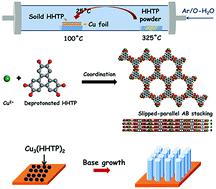当前位置:
X-MOL 学术
›
Mater. Chem. Front.
›
论文详情
Our official English website, www.x-mol.net, welcomes your
feedback! (Note: you will need to create a separate account there.)
Solid–solid interface growth of conductive metal–organic framework nanowire arrays and their supercapacitor application
Materials Chemistry Frontiers ( IF 6.0 ) Pub Date : 2019-11-20 , DOI: 10.1039/c9qm00527g Xing Du 1, 2, 3, 4, 5 , Jianing Zhang 1, 2, 3, 4, 5 , Huali Wang 5, 6, 7, 8 , Zhaohui Huang 5, 6, 7, 8 , Ankang Guo 1, 2, 3, 4, 5 , Lei Zhao 1, 2, 3, 4, 5 , Yue Niu 4, 5, 9, 10, 11 , Xianglong Li 4, 5, 9, 10, 11 , Bin Wu 1, 2, 3, 4, 5 , Yunqi Liu 1, 2, 3, 4, 5
Materials Chemistry Frontiers ( IF 6.0 ) Pub Date : 2019-11-20 , DOI: 10.1039/c9qm00527g Xing Du 1, 2, 3, 4, 5 , Jianing Zhang 1, 2, 3, 4, 5 , Huali Wang 5, 6, 7, 8 , Zhaohui Huang 5, 6, 7, 8 , Ankang Guo 1, 2, 3, 4, 5 , Lei Zhao 1, 2, 3, 4, 5 , Yue Niu 4, 5, 9, 10, 11 , Xianglong Li 4, 5, 9, 10, 11 , Bin Wu 1, 2, 3, 4, 5 , Yunqi Liu 1, 2, 3, 4, 5
Affiliation

|
The chemical vapour deposition (CVD) method has offered a new possibility of preparing metal–organic frameworks (MOFs). However, the reported MOF-CVD method is limited to the use of gaseous organic precursors, preventing the extension of the CVD method to a broad range of potential organic linkers. This study, for the first time, reports a dual-temperature zone CVD-assisted approach for the in situ growth of conductive Cu3(HHTP)2 (HHTP = 2,3,6,7,10,11-hexahydroxytriphenylene) nanowire arrays (NWAs) on the interface between a solid Cu foil and a solid organic precursor, overcoming the difficulties of high sublimation temperatures of organic ligands and low decomposition temperatures of conductive MOFs. In the process, oxygenated water (O-H2O) is the key to obtain crystalline Cu3(HHTP)2 NWAs, and the growth is described by a base-growth mode. A symmetrical supercapacitor based on Cu3(HHTP)2 NWAs on the Cu foil shows a high specific surface area normalized capacitance of 41.1 μF cm−2 for 0.5 A g−1, which is 2–5 times higher than those of most carbon materials. This study demonstrates the extension of the synthesis method from the previous liquid or gas based reaction to a solid–solid reaction, and this extension is expected to be very useful for the production of a broad range of conductive MOFs and their direct supercapacitor application.
中文翻译:

导电金属-有机骨架纳米线阵列的固-固界面生长及其超级电容器应用
化学气相沉积(CVD)方法为制备金属有机骨架(MOF)提供了新的可能性。但是,已报道的MOF-CVD方法仅限于使用气态有机前体,从而阻止了CVD方法扩展到广泛的潜在有机连接基。这项研究首次报道了双温区CVD辅助方法用于导电Cu 3(HHTP)2(HHTP = 2,3,6,7,10,11-六羟基三亚苯基)纳米线阵列的原位生长固态铜箔和固态有机前体之间的界面上具有(NWAs),克服了有机配体的高升华温度和导电MOF的低分解温度的难题。在此过程中,含氧水(OH 2O)是获得结晶Cu 3(HHTP)2 NWA的关键,其生长用碱生长模式描述。Cu箔片上基于Cu 3(HHTP)2 NWA的对称超级电容器显示出0.5 A g -1的高比表面积归一化电容为41.1μFcm -2,这比大多数碳材料的静电容量高2-5倍。这项研究表明合成方法已从以前的基于液体或气体的反应扩展到了固-固反应,并且这种扩展有望用于生产多种导电MOF及其直接用于超级电容器。
更新日期:2019-11-20
中文翻译:

导电金属-有机骨架纳米线阵列的固-固界面生长及其超级电容器应用
化学气相沉积(CVD)方法为制备金属有机骨架(MOF)提供了新的可能性。但是,已报道的MOF-CVD方法仅限于使用气态有机前体,从而阻止了CVD方法扩展到广泛的潜在有机连接基。这项研究首次报道了双温区CVD辅助方法用于导电Cu 3(HHTP)2(HHTP = 2,3,6,7,10,11-六羟基三亚苯基)纳米线阵列的原位生长固态铜箔和固态有机前体之间的界面上具有(NWAs),克服了有机配体的高升华温度和导电MOF的低分解温度的难题。在此过程中,含氧水(OH 2O)是获得结晶Cu 3(HHTP)2 NWA的关键,其生长用碱生长模式描述。Cu箔片上基于Cu 3(HHTP)2 NWA的对称超级电容器显示出0.5 A g -1的高比表面积归一化电容为41.1μFcm -2,这比大多数碳材料的静电容量高2-5倍。这项研究表明合成方法已从以前的基于液体或气体的反应扩展到了固-固反应,并且这种扩展有望用于生产多种导电MOF及其直接用于超级电容器。











































 京公网安备 11010802027423号
京公网安备 11010802027423号